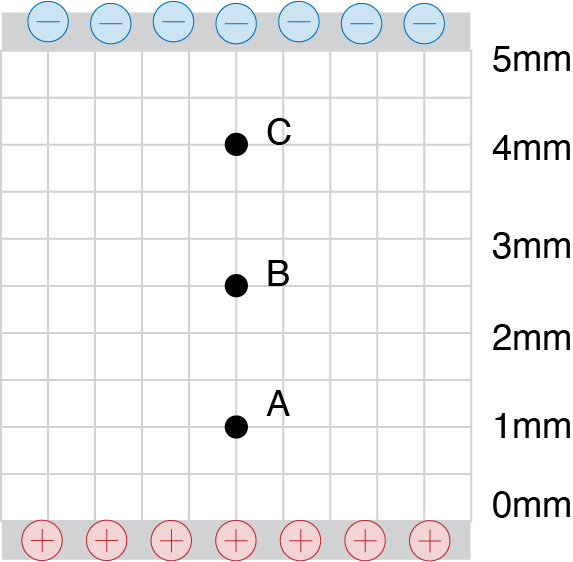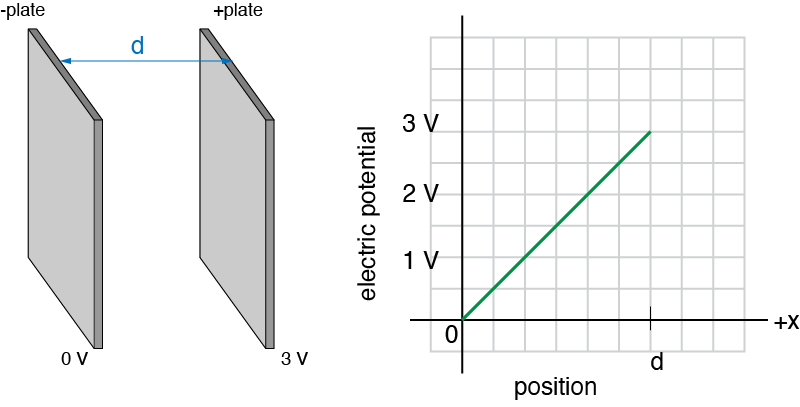The SI units used to describe the strength of an Electric Field are
- volts per couloub
- newtons per coulomb
- newtons per meter
- None of the above
The positively charged particle is moved from the initial location, marked i, to a final position marked f. The central negative charge is stationary. Which choice best describes the potential energy of the positive charge after being moved to point i?

- The potential energy has increased.
- The potential energy has decreased.
- The potential energy stays the same.
- The potential energy is always zero.
The positively charged particle is moved from the initial location, marked i, to a final position marked f. The central negative charge is stationary. Which choice best describes the potential energy of the positive charge after being moved to point i?

- The potential energy has increased.
- The potential energy has decreased.
- The potential energy stays the same.
- The potential energy is always zero.
The positively charged particle is moved from the initial location, marked i, to a final position marked f. The two charged plates are fixed in place. Which choice best describes the potential energy of the positive charge after being moved to point i?

- The potential energy has increased.
- The potential energy has decreased.
- The potential energy stays the same.
- The potential energy is always zero.
The negatively charged particle is moved from the initial location, marked i, to a final position marked f. The two charged plates are fixed in place. Which choice best describes the potential energy of the negative charge after being moved to point i?

- The potential energy has increased.
- The potential energy has decreased.
- The potential energy stays the same.
- The potential energy is always zero.
The electric potential of a test charge near a positive point charge depends on the distance $d$ between the charges. What is the functional relation between Electric Potential ($V$) and distance $d$? (The symbol $\propto$ means proportional to.)
- $V \propto d^1$
- $V \propto d$
- $V \propto d^{-1}$
- $V \propto d^{-2}$
The electric field near a positive point charge depends on the distance $d$ between the charges. What is the functional relation between Electric Field ($E$) and distance $d$? (The symbol $\propto$ means proportional to.)
- $E \propto d^1$
- $E \propto d$
- $E \propto d^{-1}$
- $E \propto d^{-2}$
The figure below shows a parallel plate capacitor geometry which means two large plates are given equal and opposite charges and fixed in place. At which of the labeled points is the electric field the greatest?

- Point A (1.0 mm from + plate)
- Point B (2.5 mm from + plate)
- Point C (4.0 mm from + plate)
- The field is the same at each of the 3 locations.
If a positive test charge is released from rest in the vicinity of a positive point charge (fixed in place), the positive test charge will be repelled due to the Coulomb force acting on it and quickly accelerates away from the point charge. In terms of electric potential, which would be the best way of explaining this phenomenon:
- The test charge is moving along equipotential lines as it is repelled.
- The test charge moves in the direction of decreasing electric potential.
- The test charge moves in the direction of increasing electric potential.
- There is no simple relation between electric force and electric potential to explain this.
Two electric charges of equal mass but different charge are released from rest an allowed to move freely. Which one of the following choices would NOT be a possible outcome.
- The charges move closer and each charge has the same magnitude of acceleration.
- The charges move father apart and each charge has the same magnitude of acceleration.
- One charge stays almost still and the other quickly accelerates towards the stationary one.
- None of these are possible outcomes.
For a standard parallel plate capacitor, increasing the surface area of both the opposing plates by a factor of two will:
- double its capacitance.
- quadruple its capacitance.
- have no effect on its capacitance.
- decrease its capacitance by half.
Two plates are arranged as shown a distance $d$ apart. The Right plate has +3 V applied to it and the left plate is held at 0 volts (ground). Shown is the electric potential as a function of position between the plates. Which of following statements is true.

- The electric field between the plates is strongest near the +3 plate.
- The electric field between the plates is strongest near the 0 volt plate.
- The electric field between the plates is constant, because the first derivative of the electric potential with respect to position would be a flat horizontal line.
- There is no electric field present between the plates since there are no charges in that area.





